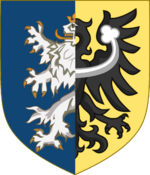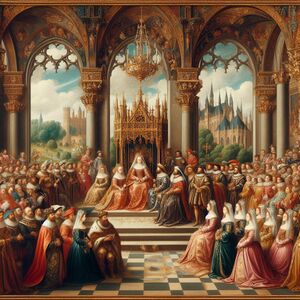House of Pṙemysl-Adlerthal
| Pṙemysl-Adlerthals Pṙemysl-Adlerthálowé Premysl-Adlerthal | |
|---|---|
| Royal house | |
 Official Coat of Arms of the Pṙemysl-Adlerthals since 1800 | |
| Parent family | House of Adlerthal House of Pṙemysl |
| Country | Morrawia |
| Etymology | Union between the families of Pṙemysls and Adlerthals |
| Place of origin | Morrawia |
| Founded | 1556 |
| Founder | Ludmila I |
| Final ruler | Joseph III |
| Final head | Josef Adlerthal Jr. (died 1957) |
| Titles | King of Gothians Emperor of Morrawia Kening of the Gotos Islands |
| Style(s) | Imperial Majesty Grace Royal Highness |
| Connected members | Ludmila I, Francis I, Joseph I, Joseph III |
| Connected families | House of Qwerteinheimer |
| Distinctions | Imperial Order of the Golden Eagle and Lion Royal Order of Germans and Morrawians |
| Traditions | Catholicism, German nationalism, Morrawian nationalism |
| Motto | Mit Ehre und Gott zum Sieg! (With Honour and God Towards Victory!) |
| Estate(s) | Holowec Castle (ancestral) Castle Adlerthal (ancestral) Grand Imperial Palace (formal) |
| Dissolution | 1856 |
| Deposition | 1856 (following the imperial defeat in the Great Morrawian Revolution and establishment of the Republic of Morrawia) |
| Cadet branches | Adlerthal-Ambrunn Pṙemysl-Králowec Honsburg Adlerthal-Este |
The House of Pṙemysl-Adlerthal (German: Haus Premysl-Adlerthal, Morrawian: Dynastie Pṙemysl-Adlerthálů) originated from the marriage in 1556 of Ludmila I, Queen of Morrawia, and Francis Adlerthal, Duke of Baweria, Archduke of Elbennia and Count of Banawia. Its members are the legitimate surviving line of both the House of Pṙemysl and the House of Adlerthal and inherit their patrimonial possessions from their female line of the House of Pṙemysl and from the male line of the House of Adlerthal.
The House of Pṙemysl takes its name from its first mythical ruler, Pṙemysl, though the first documented ruler was the Duke Pṙemysl I, starting to rule Duchy of Morrawia in 907. The House of Pṙemysl gathered dynastic momentum during the 11th, 12th and in 1131, Kingdom of Morrawia was born with Wladislaw I as the first king. Meanwhile, the House of Adlerthal was known as the smaller befriended house ruling mostly northern Morrawia at that time. The momentum continued during the 13th and 14th centuries with the 15th century being marked by the Crisis of the 15th century, finally resulting in the merger of the royal houses in the half of the next century. From that point, Adlerthal branch of the union became more and more dominant up until their dissolution in 1856.
The current house orders are the Imperial Order of the Golden Lion, Imperial and Royal Order of Eagle of Three German States and Order of the Elbennican Cross. The House of Pṙemysl-Adlerthal does not exist anymore, with the last remaining descendant dying in 1957.
History of the dynasty
The first member of the House of Pṙemysl-Adlerthal to rule over the Morrawian lands was Ludmila I, a sovereign raised during the Renaissance. By the new ideals she brought, she continued many reforms, started by her predecessor Aneż I, most of which were in the areas of taxation, economy and military, especially navy contruction. She was insistent on expanding Morrawia's power and by signing a Veligrad Proclamation in 1567 formalized slave trade practice in Morrawia. Upon her death in 1579, she was succeeded by her brother Pṙemysl III, who established Morrawia as one of the major powers of the world. He also invited a lot of foreign diplomats to expand the influence of Morrawia and create new alliances.
Rules of Ladislaw II and Pṙemysl IV were marked mostly by the continued increase in Morrawia's foreign capabilities.
In 1621, Pṙemysl's son, Pṙemysl V, was crowned king. With him, Morrawia saw the first real efforts of power centralization and the move to absolutism. This was greatly opposed in the 1630s in the form of Silk Rebellion, yet unsuccessfully with the Feudal Purge in 1644 being the sign of that. On 30th May 1645, Pṙemysl V crowned himself the "Emperor of all Morrawian people", officially Emperor of Morrawia, becoming Pṙemysl I.
Almost immediately rapid German takeover of the house took place with no monarchs from the Pṙemysl branch after the rule of Pṙemysl I. Beginning with Francis I, territorial and imperialistic ambitions took hold as the core principle in the domestic and foreign policy of the Empire with neighbouring states falling one by one to the much more technologically advanced and much more trained Imperial Army.
In 1776, last female member of the Pṙemysl branch of the House of Pṙemysl-Adlerthal died, thus only the german wing remained.
Morrawian slave trade reached its peak by the turn of the 18th century with the country overall entering the Slow Decline Era just 10 years later. Attempts at reversing or at least slowing down this process were made along the way by several emperors, notably Emperor Joseph I, credited with modernizing Morrawian legal system, which later became the basis for the republican legal system of today. Alongside it, reforms in individual rights, agriculture, creation of the first functioning legislature and the start of the Industrial Revolution in Morrawia meant that generally, country was doing well.
Even cadet branches of the main royal house were pushed out of their territories and were at best made territorial governors of the oversees territories. This created a general chaos in the broader ruling family and accelarated the decline of the power of the country and the house overall.
End of the rule of the House of Pṙemysl-Adlerthal
The House of Premysl-Adlerthal's grip on power was gradually slipping away as the Republican movement gained momentum in Morrawia. In 1852, the Legislative Assembly, with the support of townsmen, sympathetic aristocracy, and other noblemen, officially declared the Republic of Morrawia. The Emperor Joseph III was quickly captured by an angry mob and held hostage in the Grand Imperial Palace in Králowec.
Despite the setback, the Republican forces pressed on, and in early September 1853, they decisively defeated the Imperial Army in the Battle of Králowec, securing control of the city and capturing the Emperor and his family.
In 1856, the tide of war finally turned decisively in favor of the Republicans. The Battle of Faríṙ, one of the bloodiest battles of the war, resulted in the surrender of the last pockets of imperial resistance. The Emperor Joseph III, now going by the civilian name Joseph Adlerthal, was forced to abdicate, and the Great Morrawian Revolution officially ended.
The Republic of Morrawia was born, and Tristan Palacký was unanimously elected President and he chose a more humane approach to the formal sovereign and his family. Unlike it was popularly demanded, Joseph III was not executed, but merely imprisoned alongside his immediate familly for 5 years and later give amnesty under new citizen identity in the newly established Republic of Morrawia.
With that the ruling house was disbanded and the last surviving descendant, Josef Adlerthal Jr., prominent governor of Baweria, later representative and senator for that state, died in 1957 of heart failure at the age of 65 with no living children.

